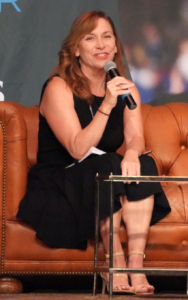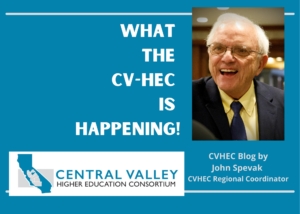WHAT THE CV-HEC IS HAPPENING BLOG (December 2023): The gift of math
For our year-ending “What the CV-HEC is Happening” Blog, here’s a holiday story of sorts by Dr. John Spevak that was published in his column for the Los Baños area (Merced County) newspaper, The Westside Express, Dec. 19. Dr Spevak, who is a vice president-emeritus of Merced College and currently a regional coordinator for CVHEC, coordinates the English and Math Task Forces for the consortium — all champions for student support through such measures as dual enrollment. He provides a personalized window into the founder of College Bridge which is partnering with CVHEC for the Central Valley Math Bridge Program, a math intervention that is utilizing dual enrollment in bringing together consortium community college members with their respective high schools across the central valley.
The gift of math … for students who don’t think they’re mathematical
BY DR. JOHN SPEVAK
CVHEC Regional Coordinator
Vice President-Emeritus – Merced College
Here’s a good question for the Christmas season: What’s the most unusual gift you’ve ever heard of?
I think I have a gift that can top your answer — the gift of math. And I know how that gift can be given—through an innovative program called “Math Bridge,” which before long will be coming to Pacheco High School in Los Banos and later to Dos Palos High School and perhaps Firebaugh High School, too.
Now before all of you who hated math or felt you weren’t good at math skip the rest of the column or sigh in skepticism, let me explain.
Imagine that before you graduated from high school someone had told you that you could be good at math. And imagine further that they enabled you not only to be good at math but to enjoy it and even become passionate about it.
That could have well happened to you if you were a high school student in the Central Valley Math Bridge Program. And your success in math could have opened all kinds of doors for you, in careers related to science, engineering, accounting and computer science, to name a few–careers that are in high demand and pay well.
If you’re still with me, dear reader, your curiosity may have been stirred to the point where you’re now asking, “How in the world can Math Bridge do that?”
Before I answer that question I need to tell you a story. Once upon a time there was a girl in high school, named Lynn, who liked math but didn’t like school, at least the part about being confined to a desk hour after hour each day. She had had some tough times as a teenager, including a period when she was homeless and dropped out of high school at age 15.
One day Lynn, who had decided she should at least get a high school diploma equivalent, started studying math to pass the math section of the GED test and that rekindled her love for math, so much so that after earning her GED, she went on to college and majored in math.
She earned good grades in her college math classes. Along the way she remembered what some middle school and high school teachers had told many students when they said, “You’ll never be good at math.” Sometimes this was said to girls like her, when some male math teachers didn’t think girls could succeed at math.
Not only did Lynn earn her bachelor’s degree in mathematics and secondary education from Boston College, she also went on to earn a master’s degree and then a doctoral degree (an E.D. from UCLA). She soon discovered her purpose in life as she sees it: to show high school students who don’t think they are good at math that they could indeed succeed in math.
She was determined to give them the gift of math.

Dr. Lynn Ceballos, president of College Bridge, presenting on the Math Bridge Program at the CVHEC Summit in October.
Dr. Lynn Cevallos eventually started a nonprofit organization called College Bridge about 10 years ago and created a partnership with the Los Angeles Unified School District and California State University Los Angeles, calling it SLAM, the South Los Angeles Math Project, and initiated a nine-year longitudinal study. More than 160 students from six cohorts in three urban LAUSD high schools participated in the project.
In this project Lynn wanted only students who weren’t considered good at math to participate. She needed and received extensive and significant help from high school math teachers and university math professors who worked collaboratively to help students succeed.
They created a program called Math Bridge in which high school students enrolled in a dual enrollment transferable math class while they were in high school.
The results were astounding. The six cohorts of high school students had an average pass rate of 75 percent in a transferable math course compared with an average of 71 percent for the same course taught at CSULA. And the program increased the students’ confidence, with 92 percent considering themselves after completing the program ready for college.
Now Lynn has brought her project to the Central Valley. She has helped create a partnership that involves College Bridge, the Central Valley Higher Education Consortium (CVHEC), Fresno Pacific University and the Rand Corporation to develop the Central Valley Math Bridge Program with eight Central Valley community colleges and many of their feeder high schools.
The colleges who have so far signed on to the project are Cerro Coso, Columbia, Madera, Reedley, San Joaquin Delta in Stockton, Taft, West Hills-Coalinga and Merced.
A number of high schools in Merced County have signed on to the project, including Pacheco High School in Los Banos. Dos Palos High School plans to sign on next year. More might be joining later.
Since West Hills College Coalinga is part of Math Bridge, it’s a good bet that at some point Firebaugh High School will also participate.
The Math Bridge project requires a lot of work not only by Lynn and others who are now part of the College Bridge staff, but also by many high school math teachers and many college math professors.
For this project to work, high school educators need to identify students struggling in mathematics, then design interventions using a blend of college and high school math courses, and then create college and high school instructional teams working collaboratively to analyze student work for continuous improvement.
I’m excited about the project. Over the years as an educator, I’ve heard so many people, young and old, say they’re not good at math and never will be. I believe Math Bridge will change the perceptions of the high school students who will be a part of the project. They will realize they can be good at math.
That will be good for them and their families. And for the state and the country.
We need more young people to go on to college and then into math-based careers, especially in computers, science, and engineering, if we want our country to be the world’s innovative leader in these fields. This will be good for our country’s strength–and its security.





Leave a Reply
Want to join the discussion?Feel free to contribute!